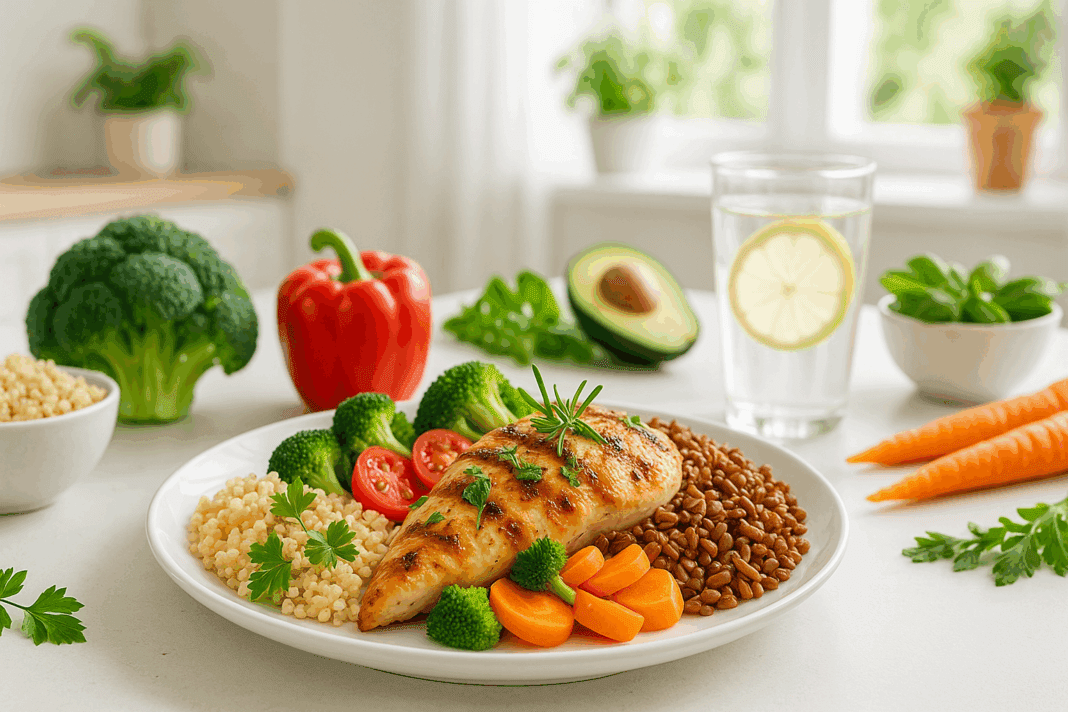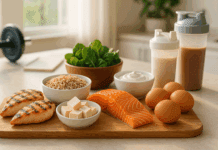A well-balanced diet is a foundational pillar of health, and one of the most effective ways to ensure you meet your nutritional goals is by incorporating a healthy chicken dish into your daily routine. Chicken, as a lean protein, offers remarkable versatility in the kitchen and impressive health benefits on the plate. From aiding in muscle recovery to supporting weight loss, healthy chicken meals can be the cornerstone of nutritious eating. For those navigating the terrain of high-protein diets, chicken stands out as a valuable and adaptable ingredient that brings both flavor and function to your plate. This article explores twenty-five expert-approved strategies to revolutionize your nutrition with chicken-based meals, showcasing the healthiest chicken recipes and guiding you through creative ways to cook healthy chicken without compromising taste or health.
You may also like : The Ultimate High-Protein Nutrition Plan: How to Gain Muscle in Women Safely and Effectively
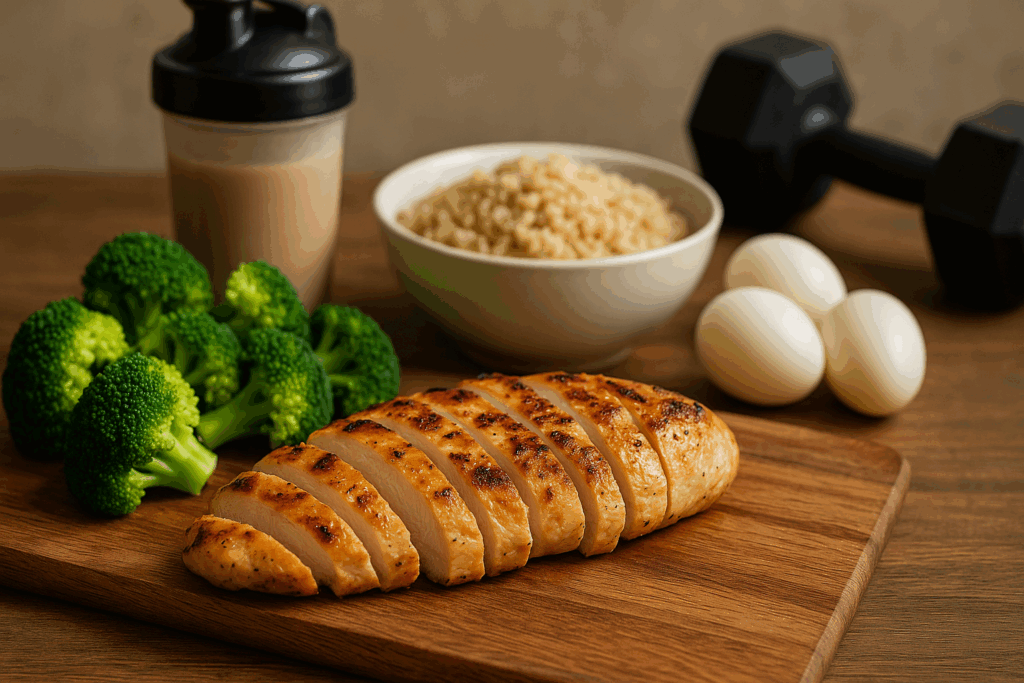
Harnessing the Power of Lean Protein for Sustainable Energy
Protein is crucial for building muscle, supporting cellular repair, and promoting satiety. Chicken, particularly the breast, is one of the healthiest sources of lean protein available. By incorporating healthy chicken breast dinner recipes into your meal planning, you can support sustained energy throughout the day. Unlike processed or fatty meats, chicken offers a clean, digestible source of amino acids essential for both active lifestyles and sedentary individuals seeking metabolic balance. Integrating easy healthy chicken dinner ideas can elevate your nutrition while keeping preparation simple and approachable.
Elevating Flavor with Herbs and Spices Instead of Salt or Fat
A common pitfall in cooking is the overuse of sodium or saturated fats to boost flavor. However, with a healthy chicken dish, you can rely on herbs, spices, and aromatic vegetables like garlic, rosemary, turmeric, and paprika to create a depth of flavor that is both health-conscious and satisfying. These ingredients not only enhance the taste but also deliver anti-inflammatory and immune-supportive benefits. Swapping heavy cream sauces for citrus zest, fresh basil, or a drizzle of olive oil can create easy healthy chicken recipes that are as medicinal as they are delicious.
Understanding the Cultural Symbolism and Ritual Uses of Chicken
Across cultures, chicken holds symbolic value in rituals, celebrations, and ancestral cuisine. In Jewish tradition, chicken soup is colloquially known as “Jewish penicillin” due to its healing reputation. In Chinese New Year celebrations, serving a whole chicken symbolizes family unity and prosperity. Appreciating these cultural dimensions when preparing a healthy chicken dish can add meaning and mindfulness to the cooking process. When food is seen as both nourishment and cultural expression, it becomes a more profound experience beyond nutrition alone.
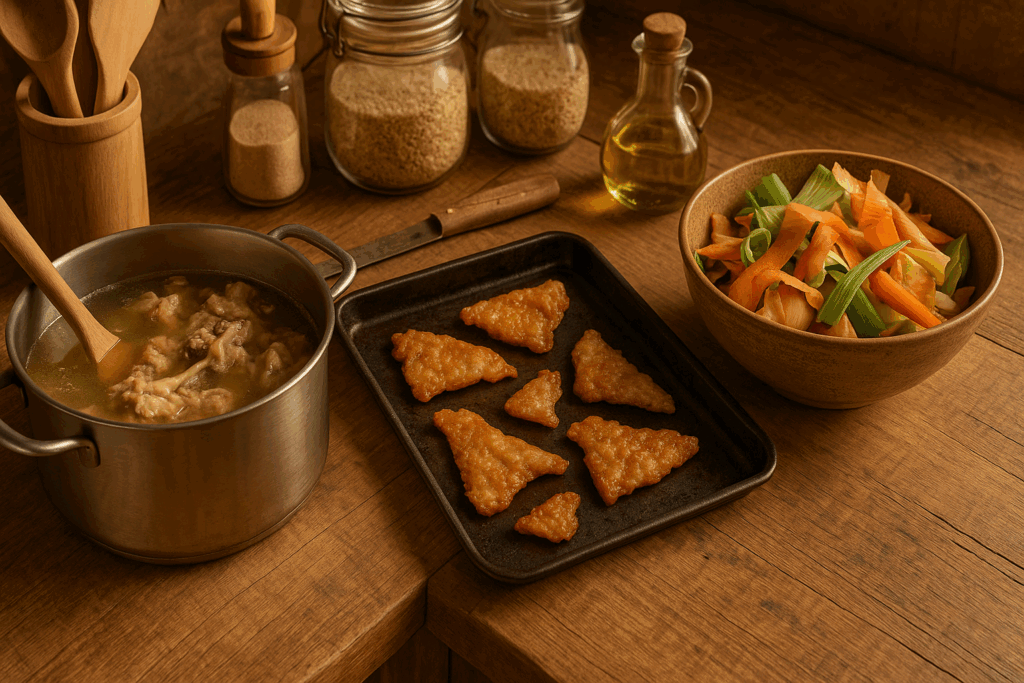
Creating Sustainable Chicken Meals with Zero-Waste Cooking
Sustainability in nutrition involves not just ingredient choices but also the minimization of waste. Utilizing every part of the chicken—including bones for broth, skin for flavor, and even rendered fat for future cooking—promotes environmental consciousness. Broths made from bones and vegetable scraps serve as mineral-rich bases for soups, stews, or risottos. Chicken skin, when baked until crispy, can serve as a crunchy salad topper, reducing the need for processed croutons. Zero-waste cooking fosters a deeper respect for ingredients while supporting health and sustainability.
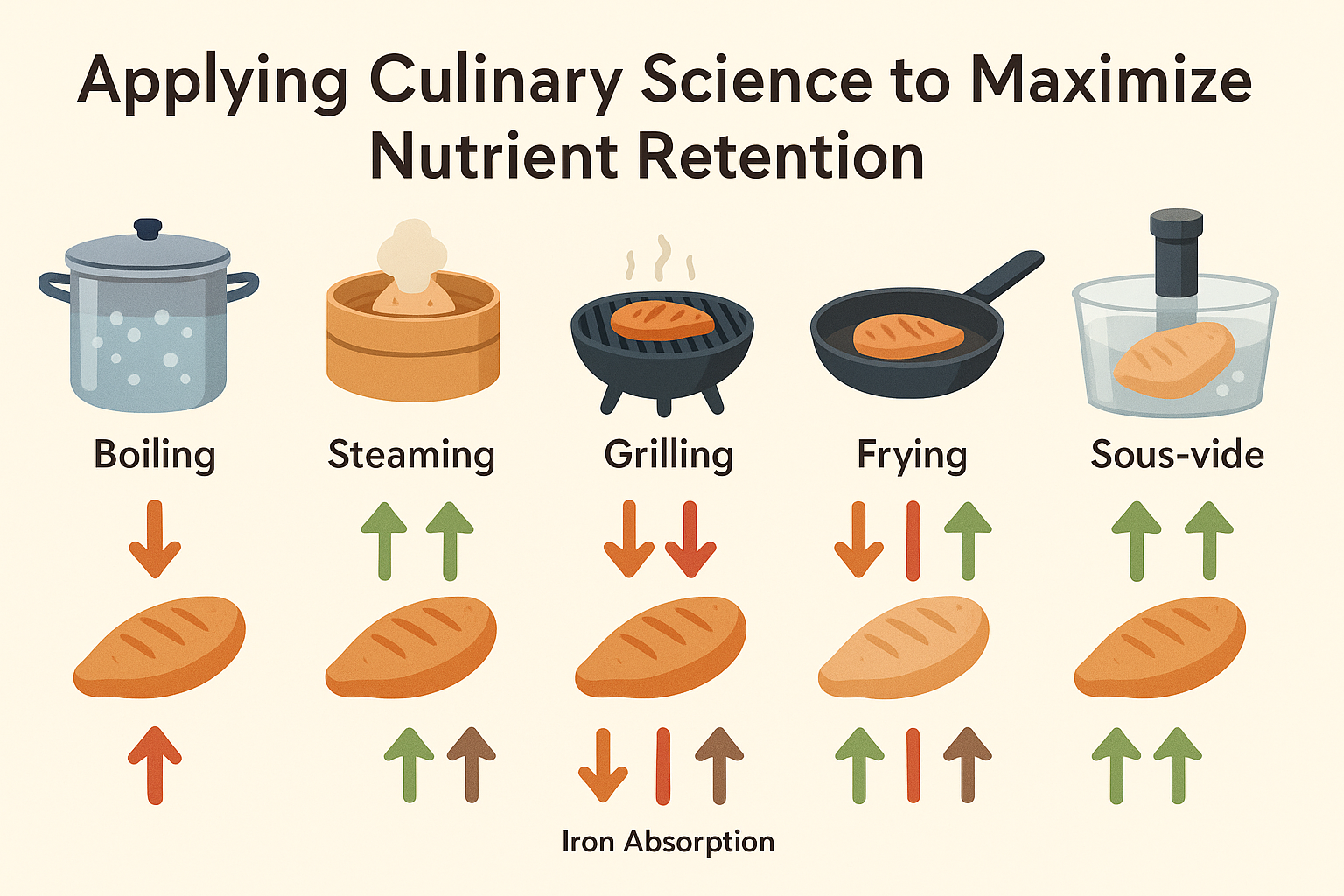
Applying Culinary Science to Maximize Nutrient Retention
Scientific studies show that different cooking methods affect the nutrient profile of chicken. Boiling and steaming generally preserve more B vitamins and minerals, whereas frying and over-roasting can degrade heat-sensitive compounds. Utilizing low-heat techniques and minimizing cooking time can help retain nutrients like niacin, selenium, and pantothenic acid. Pairing chicken with ingredients high in vitamin C, such as bell peppers or citrus, also enhances iron absorption. Applying nutritional biochemistry principles in the kitchen helps turn your healthy chicken meals into bioavailable, nutritionally optimized creations.
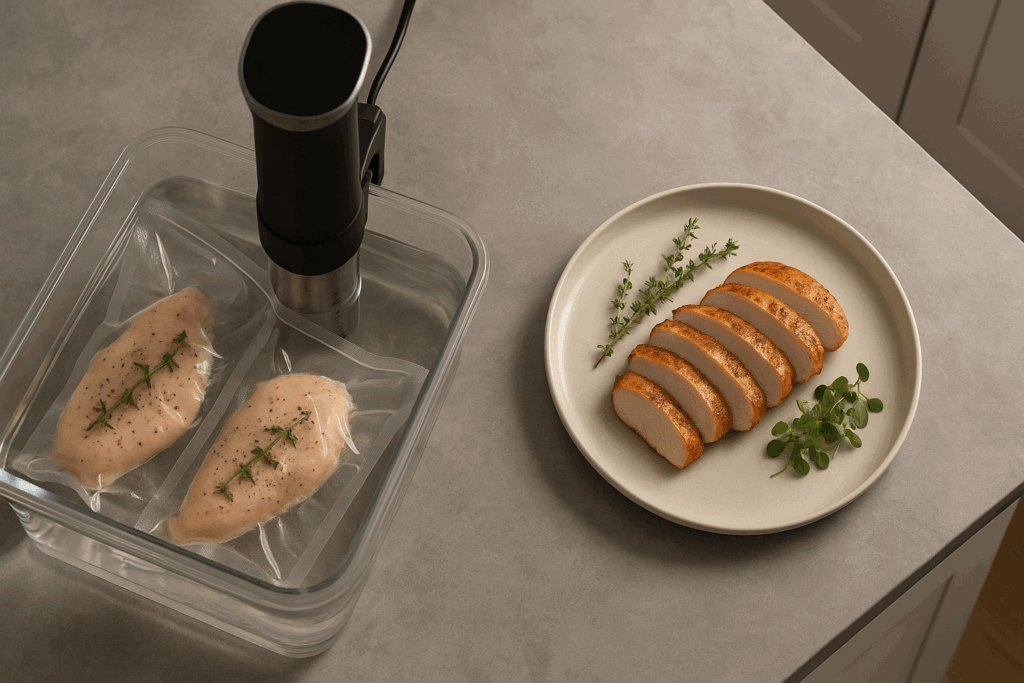
Crafting Restaurant-Quality Chicken with Sous-Vide Cooking
Sous-vide, a French cooking technique that involves vacuum-sealing food and cooking it slowly in a water bath, can elevate the texture and flavor of chicken to restaurant quality without added fats. Cooking chicken breast sous-vide at precise temperatures preserves moisture, tenderness, and nutrients while eliminating the risk of overcooking. You can then finish the chicken with a quick sear in olive oil or ghee for flavor enhancement. This method offers an efficient way to prepare foolproof, consistently juicy healthy chicken recipes for both beginners and gourmet home chefs.
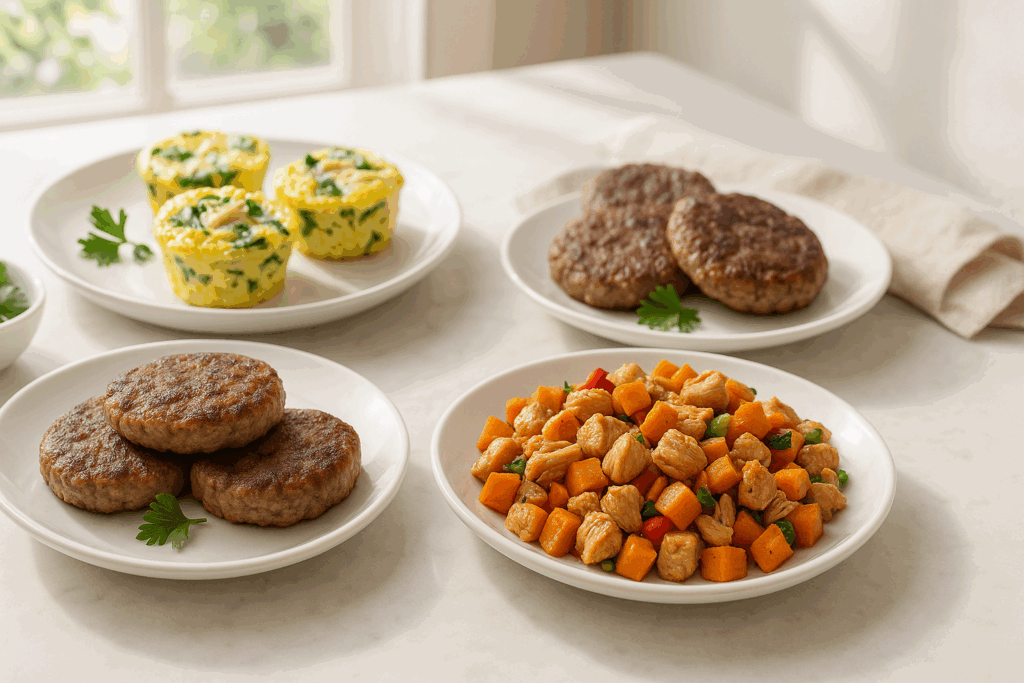
Reimagining Chicken for Breakfast: High-Protein Morning Fuel
Chicken is not confined to lunch and dinner menus. It can also play a valuable role in breakfast when reimagined creatively. Ground chicken sausage with herbs, chicken egg muffins, or chicken and sweet potato hash with poached eggs make excellent high-protein breakfasts that stave off mid-morning hunger and stabilize blood sugar. Swapping processed pork sausage for a lean chicken version cuts saturated fat while preserving satisfaction. These breakfast-friendly healthy chicken dish ideas give you a head start on protein goals, especially for active individuals or those following intermittent fasting schedules.
Incorporating Anti-Inflammatory and Adaptogenic Herbs into Chicken Dishes
Going beyond standard seasonings, anti-inflammatory herbs such as turmeric, ginger, holy basil, and ashwagandha can be seamlessly integrated into chicken dishes to enhance healing and stress resilience. A turmeric-laced chicken curry made with coconut milk, garlic, and ginger provides warmth and anti-inflammatory support ideal for individuals managing arthritis or autoimmune conditions. Similarly, a roasted chicken dish seasoned with dried holy basil and cumin offers adaptogenic properties that may help the body cope with physical and emotional stress. These additions make your meals both medicinal and delicious, merging culinary enjoyment with evidence-based healing.
Balancing Omega Fatty Acids in Chicken-Based Meals
Not all chicken is created equal when it comes to fat composition. Pasture-raised chickens have a more favorable balance of omega-3 to omega-6 fatty acids compared to conventionally raised poultry. Consuming too much omega-6 relative to omega-3 has been linked to inflammation and chronic disease. By choosing better-quality chicken and pairing it with omega-3-rich ingredients such as walnuts, flaxseeds, or fatty fish like salmon, you can create a meal that encourages anti-inflammatory processes and cardiovascular health. This refined approach to constructing your healthy chicken dish brings precision to wellness-focused eating.
Mastering the Art of Grilling and Roasting for Low-Fat Cooking
One of the key techniques for preparing healthy chicken dishes for dinner is mastering low-fat cooking methods such as grilling, roasting, and baking. These methods retain moisture and enhance natural flavors without the need for excess oil or breading. A simple grilled lemon-herb chicken breast served with roasted vegetables can become a recurring staple in your repertoire of healthy meals to make with chicken. These cooking styles also help minimize exposure to trans fats and preserve the chicken’s nutrient profile, offering light chicken recipes ideal for high-protein diets.
Creating Balanced Plates with Fiber-Rich Sides
A healthy chicken dish reaches its full nutritional potential when paired with fiber-dense vegetables, legumes, or whole grains. Brown rice, quinoa, roasted sweet potatoes, or a colorful medley of steamed vegetables not only provide essential micronutrients but also help regulate digestion and blood sugar levels. Healthy chicken breast meals shine when complemented with seasonal produce, making every bite vibrant, nourishing, and complete. This balanced approach promotes digestive health and extends the feeling of fullness, reducing the likelihood of overeating.
Transforming Leftovers into New Healthy Chicken Dinners
Transforming leftover chicken into new, inspired dishes not only reduces food waste but also makes it easier to maintain consistency in healthy eating. A Sunday roasted chicken can morph into Monday’s chicken quinoa salad or Tuesday’s light chicken soup. The possibilities are endless with healthy food recipes with chicken breast that offer variety without added calories or complexity. Whether folded into whole grain wraps or mixed into vegetable stir-fries, repurposing chicken keeps meals exciting and aligned with your health goals.
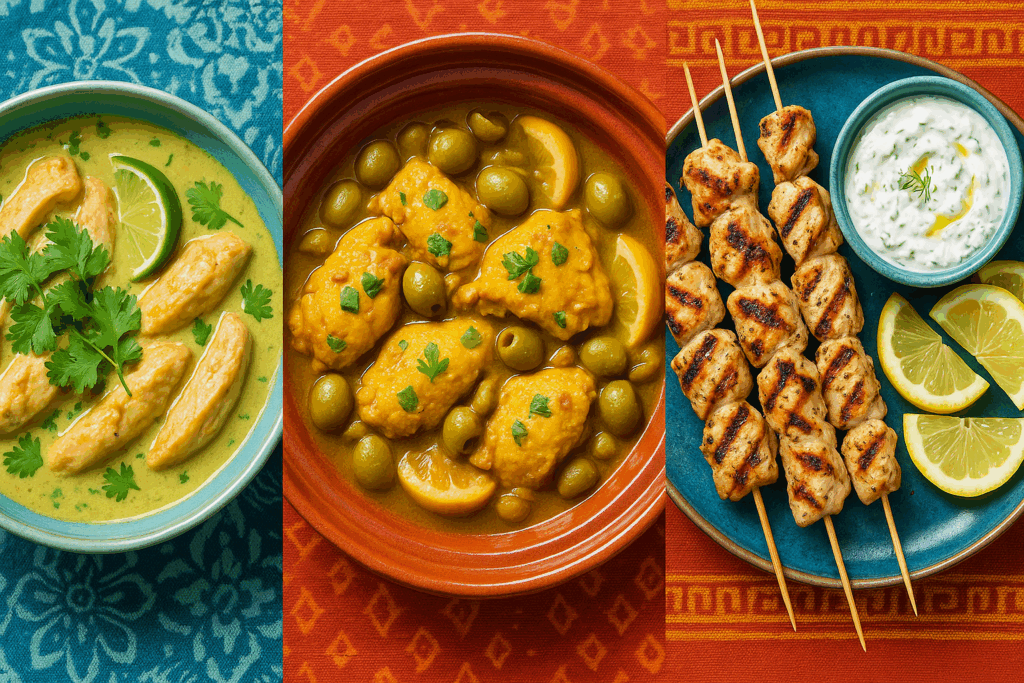
Incorporating Global Flavors for Cultural Variety and Nutritional Depth
Global cuisines offer a treasure trove of inspiration for creating healthy chicken meals for dinner. From Mediterranean lemon-oregano chicken skewers to Thai coconut-lime chicken curries made with light coconut milk, the world is full of easy healthy chicken dinner recipes that deliver bold flavors and balanced nutrition. Exploring these culinary traditions enhances your diet with diverse spices and preparation methods that may introduce additional health benefits and keep your palate engaged.
Making Chicken the Star of Your Meal Prep Routine
Meal prepping with chicken simplifies the weekly cooking process and reinforces healthy eating habits. By grilling several chicken breasts in advance and storing them in airtight containers, you can easily build quick lunches or dinners throughout the week. Combine pre-cooked chicken with pre-washed greens, whole grains, or roasted vegetables to assemble healthy chicken dinners that are ready in minutes. Consistency is key in dietary success, and a prepared fridge full of healthy chicken breast ideas streamlines nutrition in your busiest moments.
Choosing Organic or Pasture-Raised Chicken for Better Nutrition
When crafting healthy food with chicken, the quality of the poultry matters. Organic or pasture-raised chicken tends to have a more favorable omega-3 to omega-6 fatty acid ratio, higher antioxidant levels, and fewer antibiotic residues. Investing in higher-quality chicken can elevate your meals from simply nutritious to optimal. By aligning ethical sourcing with dietary excellence, you create healthy meals with chicken that support both personal well-being and environmental sustainability.
Utilizing Slow Cookers and Instant Pots for Convenience and Health
Slow cookers and Instant Pots are ideal tools for preparing easy healthy chicken dishes that retain flavor and nutrients while minimizing hands-on cooking time. Slow-cooked shredded chicken with salsa, garlic, and spices can form the base of multiple meals, from tacos to grain bowls. Pressure cooking also enhances nutrient retention, making it a smart technique for those seeking the healthiest chicken recipes that require little supervision yet deliver big results.
Exploring Soups and Stews as Comforting Healthy Chicken Dinners
A steaming bowl of chicken soup can be much more than a comfort food; it can be a nutritional powerhouse. With the right combination of lean protein, fiber, and vegetables, soups and stews can serve as easy healthy chicken recipes packed with hydration, micronutrients, and satiety. Try slow-cooking chicken with lentils, spinach, carrots, and herbs for a hearty yet low-calorie meal that aligns with high-protein dietary goals. These dishes are not only soothing but also deeply restorative.
Making Chicken Salads Nutritious, Not Caloric
Chicken salads are often misleadingly unhealthy due to heavy mayonnaise-based dressings or fatty toppings. By reimagining your chicken salad with Greek yogurt, Dijon mustard, fresh herbs, and crunchy vegetables like celery and bell pepper, you can transform it into one of the best healthy chicken recipes. This approach provides protein, probiotics, and fiber without excessive fat, making it ideal for those looking for healthy chicken dinner ideas that are light, fresh, and full of flavor.
Emphasizing Portion Control Without Sacrificing Satisfaction
Portion control is essential in any nutritional plan, yet it’s often misunderstood. You can enjoy satisfying, healthy chicken breast recipes to lose weight by prioritizing nutrient density over calorie volume. Serving three to four ounces of grilled chicken with two cups of vegetables and a small serving of whole grains can create a plate that feels abundant while remaining calorie-conscious. This method ensures your meals are both visually satisfying and nutritionally complete.
Using Marinades to Enhance Health Benefits and Flavor
Marinades do more than tenderize meat; they also contribute antioxidants and flavor without excess calories. A mixture of olive oil, lemon juice, garlic, and oregano not only boosts flavor but also improves nutrient absorption and provides heart-healthy fats. By avoiding store-bought sauces that are often high in sugar or preservatives, and instead opting for DIY marinades, you turn a simple meal into a healthy chicken dish that is both gourmet and functional.
Experimenting with Grain Bowls for Complete Meals
Grain bowls are a versatile format for building healthy meals to cook with chicken. Start with a base of quinoa or brown rice, then layer on grilled chicken, leafy greens, roasted vegetables, seeds, and a light vinaigrette. These bowls offer a colorful, nutrient-dense presentation that meets multiple dietary needs in a single meal. They also provide an ideal canvas for seasonal ingredients and global flavor profiles, keeping your healthy chicken dish ideas both dynamic and customizable.
Substituting Chicken for Higher-Fat Meats in Comfort Foods
Replacing red meat or processed meat in your favorite comfort foods with chicken can reduce saturated fat intake and promote heart health. Try chicken meatballs in spaghetti, chicken chili instead of beef, or even a chicken-based lasagna. These substitutions retain the essence of familiar dishes while turning them into healthy chicken dinners that support long-term wellness. This strategy allows you to enjoy beloved meals without straying from your health goals.
Adopting a Mediterranean Approach to Healthy Chicken Dishes
The Mediterranean diet is consistently ranked as one of the healthiest eating patterns, and chicken plays a prominent role. Combine grilled chicken with olives, tomatoes, cucumbers, feta cheese, and a drizzle of olive oil for a classic Greek-inspired salad. These ingredients synergize to reduce inflammation and support heart health. By incorporating Mediterranean principles into your healthy chicken dinner recipes, you harness a research-backed model of nutritional excellence.
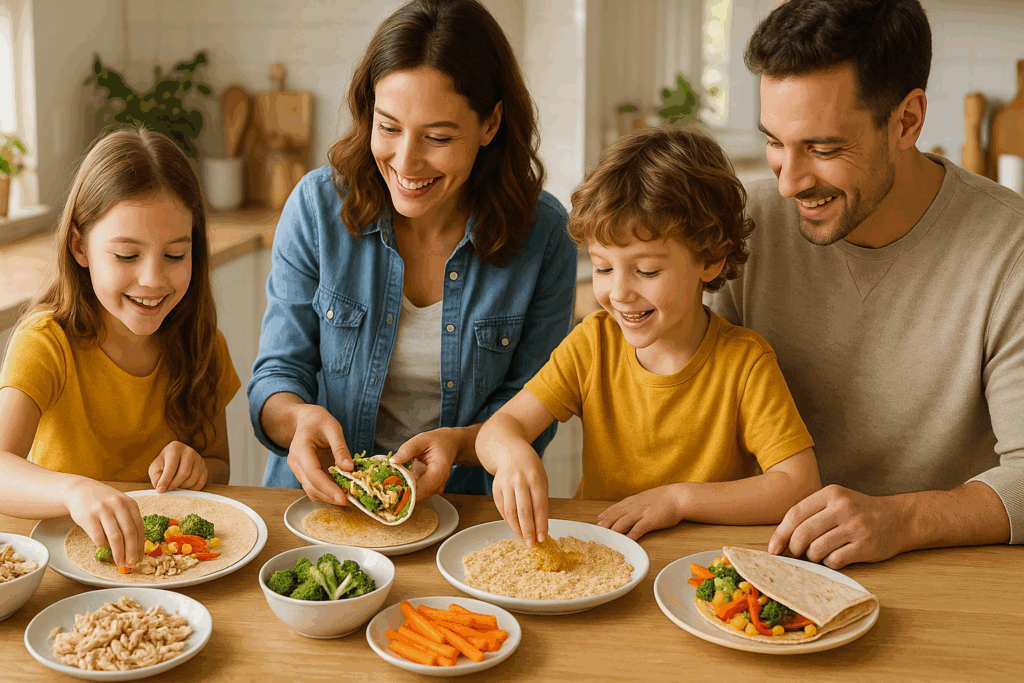
Designing Kid-Friendly Healthy Chicken Recipes the Whole Family Will Love
Encouraging children to enjoy nutritious meals can be a challenge, but chicken offers a friendly entry point. Baked chicken tenders made with almond flour, paired with homemade yogurt dip, provide a healthy chicken dish that is both fun and functional. Adding colorful vegetables to chicken quesadillas or serving shredded chicken in whole wheat wraps can turn family favorites into easy healthy chicken dinners everyone can enjoy. Teaching children the value of whole foods starts with meals that are both approachable and nourishing.
Focusing on Seasonal Ingredients to Maximize Nutritional Value
Using seasonal produce in conjunction with chicken enhances both flavor and nutrient density. Spring asparagus, summer tomatoes, fall squash, and winter greens each bring unique phytochemicals and antioxidants that elevate your healthy chicken recipes. This approach also promotes sustainability and local agriculture. By allowing the seasons to guide your meal planning, you ensure diversity in your healthy meals with chicken while tapping into nature’s rhythm.
Crafting Light Chicken Recipes for Post-Workout Recovery
After intense physical activity, your body needs high-quality protein and hydration. A light chicken stir-fry with bell peppers and broccoli, paired with brown rice, delivers the glycogen replenishment and amino acids necessary for recovery. These easy healthy chicken recipes are essential for athletes and active individuals seeking muscle repair without unwanted calories. Keeping meals light yet replenishing is key for optimizing fitness and metabolic health.
Building Healthy Freezer Meals with Chicken for Long-Term Planning
Preparing and freezing meals in advance saves time and reduces the temptation to opt for unhealthy takeout. Cook healthy chicken dishes in batch portions and freeze them in labeled containers. Chicken and vegetable soups, enchiladas, or grain bowls all freeze well and reheat with ease. Having these healthy chicken dishes for dinner on hand ensures that convenience never compromises nutrition. With planning, even the busiest lifestyle can be supported by high-protein, health-conscious meals.
Frequently Asked Questions: Expert Insights into Creating and Enjoying the Perfect Healthy Chicken Dish
1. How can I elevate the flavor of a healthy chicken dish without using high-sodium sauces or processed marinades?
Elevating flavor in a healthy chicken dish without relying on excess salt or pre-packaged seasonings requires a layered approach using fresh, natural ingredients. Start by incorporating umami-rich foods like sun-dried tomatoes, mushrooms, or tamari (a low-sodium soy sauce alternative) into your recipes. These elements create depth without overwhelming the palate. Fermented ingredients such as miso paste or kimchi can add a tangy complexity that complements lean chicken while supporting gut health. Additionally, roasting garlic, caramelizing onions, or using spice blends like za’atar or berbere can transform simple healthy chicken recipes into multidimensional meals. These techniques ensure your meals remain part of the healthiest chicken recipes category while bursting with flavor.
2. What are some surprising ways to include healthy chicken in breakfast meals?
Healthy chicken doesn’t have to be reserved for lunch or dinner—it can also play a dynamic role in breakfast. One underrated strategy is creating ground chicken patties seasoned with herbs and cooked in olive oil for a lean, protein-rich alternative to traditional sausage. Another approach is using shredded chicken in high-protein egg muffins alongside spinach and bell peppers. Chicken can also be added to savory oatmeal or sweet potato hash for a fiber-rich, energizing morning dish. These easy healthy chicken recipes boost satiety and prevent blood sugar crashes, particularly beneficial for those with active mornings or intermittent fasting routines. By diversifying your use of chicken, you extend its benefits beyond dinner and reinforce its status as a reliable cornerstone in healthy meals to cook with chicken.
3. How does the quality of chicken—such as pasture-raised versus conventionally farmed—impact health outcomes?
The nutritional quality of a healthy chicken dinner can vary greatly depending on the sourcing of the poultry. Pasture-raised chickens typically contain higher levels of omega-3 fatty acids, lower omega-6s, and more antioxidants such as vitamin E, all of which contribute to reduced systemic inflammation. They are also less likely to contain antibiotic residues or added hormones, making them a better fit for the healthiest chicken recipes. From a sustainability standpoint, pasture-raised poultry supports regenerative farming practices and better animal welfare. Choosing this type of chicken enhances the nutritional density of healthy chicken breast dinner recipes and promotes long-term health outcomes by reducing exposure to harmful additives. It also helps support ethical food systems, a vital consideration in today’s consumer landscape.
4. What role can global flavors play in creating healthy chicken breast meals that prevent dietary fatigue?
Global flavor profiles play a transformative role in keeping healthy chicken meals for dinner exciting and satisfying. When cooking with chicken regularly, it’s easy to fall into repetitive flavor cycles that dampen enthusiasm for nutritious eating. By exploring international cuisines—such as Vietnamese lemongrass chicken, Moroccan tagine with olives and preserved lemon, or Ethiopian doro wat—you can continually reinvent your healthy chicken dish. Each culture introduces distinct spice blends, cooking methods, and ingredient combinations that offer new nutritional benefits and culinary inspiration. This diversity also helps increase the intake of unique phytonutrients and plant compounds found in accompanying herbs and vegetables, deepening the health benefits of healthy meals with chicken without compromising flavor or excitement.
5. What are some advanced techniques to ensure that cooked chicken retains both flavor and nutritional integrity?
To preserve both the taste and nutrient profile of healthy chicken recipes, advanced cooking techniques such as sous-vide, steaming, or braising in bone broth are highly effective. Sous-vide allows chicken to cook evenly at lower temperatures, locking in moisture and maintaining the bioavailability of heat-sensitive vitamins. Braising chicken in bone broth not only infuses rich flavor but also adds collagen, glycine, and trace minerals beneficial for joint and gut health. Steaming with fresh herbs can protect B-complex vitamins that are otherwise lost in high-heat cooking. These techniques are particularly useful when preparing healthy chicken breast recipes to lose weight, as they require minimal fats while preserving maximum flavor and nutritional value. Such methods exemplify how culinary science can elevate healthy dinner options with chicken to gourmet quality.
6. What are some lesser-known but highly nutritious parts of the chicken that can diversify a healthy diet?
While most people default to the breast when they cook healthy chicken, other parts of the bird offer unique health benefits and can add diversity to your meals. Chicken liver, for instance, is a nutritional powerhouse rich in vitamin A, iron, and B12, making it a smart addition for those managing anemia or fatigue. Chicken hearts and gizzards provide lean protein and zinc, essential for immune support and wound healing. These organ meats can be prepared as light chicken recipes by sautéing with herbs or incorporating into rice-based dishes. Consuming a wider range of chicken parts supports nose-to-tail eating and reduces food waste, aligning with both sustainability and nutritional diversity in your healthy chicken dinners.
7. How can I integrate more vegetables into easy healthy chicken dishes without making them feel repetitive?
Integrating vegetables into easy healthy chicken dinner ideas can be an art form rather than a task. Instead of serving vegetables as side dishes, incorporate them directly into the main recipe—such as stuffing chicken breasts with spinach and sun-dried tomatoes or simmering them in tomato-based stews with eggplant, zucchini, and bell peppers. You can also puree vegetables like cauliflower or carrots into sauces to create creamy textures without dairy or excess fat. Seasonal produce swaps ensure variety and exposure to a broad spectrum of nutrients across different meals. These creative strategies make healthy food with chicken more engaging and encourage consistent vegetable consumption without falling into predictable patterns.
8. How can meal prepping help support consistency with healthy chicken dinners during a busy week?
Meal prepping with chicken simplifies nutritional planning and encourages dietary consistency, especially for working professionals or parents. By preparing components such as grilled chicken breast, roasted vegetables, and cooked quinoa in advance, you can assemble various healthy chicken dish ideas within minutes during the week. Use airtight containers and label meals by date to ensure freshness and food safety. Rotating your spice blends and sauces (e.g., chimichurri, tzatziki, tahini-lemon) keeps the meals varied even when the core ingredients remain the same. This system streamlines access to easy healthy chicken dinner recipes, helping prevent last-minute takeout decisions while promoting healthy eating habits and long-term success.
9. What psychological benefits can come from regularly preparing healthy chicken recipes at home?
Preparing healthy chicken recipes at home offers psychological benefits that extend far beyond physical nourishment. The act of cooking can foster mindfulness, reduce stress, and increase a sense of autonomy over one’s health. Familiarity with how to cook healthy chicken increases culinary confidence and reduces dependence on processed convenience foods. Sharing home-cooked meals—such as easy healthy chicken dinners—with loved ones also enhances social bonding and creates positive associations with nutritious food. Over time, these rituals can strengthen intrinsic motivation for healthy behavior and support mental wellness by aligning everyday actions with long-term health goals.
10. Why is a healthy chicken dish a smart foundation for long-term dietary sustainability and enjoyment?
A healthy chicken dish offers an ideal foundation for long-term sustainability due to its adaptability, affordability, and nutrient density. Chicken provides high-quality protein essential for muscle maintenance and metabolic function, while its mild flavor allows it to pair seamlessly with countless herbs, vegetables, and global spices. When combined with whole grains and fresh produce, it becomes part of a comprehensive eating strategy that can evolve with changing preferences and health needs. Incorporating healthy chicken breast ideas, such as bowls, stir-fries, or casseroles, keeps meals interesting and customizable. Its versatility supports not only physical health but also emotional satisfaction, making it easier to commit to healthy eating patterns without feeling deprived. Healthy chicken dishes for dinner can thus serve as a dependable cornerstone in both short-term meal plans and lifelong nutrition journeys.
Conclusion: Embrace the Simplicity and Power of a Healthy Chicken Dish
Transforming your eating habits begins with small, intentional changes—and integrating a healthy chicken dish into your daily diet is one of the most effective ways to do so. Whether you’re exploring easy healthy chicken dinner recipes, reinventing comfort food classics, or building nutritious grain bowls, chicken provides a versatile and nourishing foundation. By focusing on preparation techniques, portion control, ingredient quality, and global inspiration, you can create healthy meals to cook with chicken that satisfy both body and soul. These 25 expert-approved strategies offer not only practical guidance but also a roadmap to long-term health, vitality, and culinary enjoyment. Lean into the simplicity of chicken, and let it elevate your plate into a celebration of wellness.


